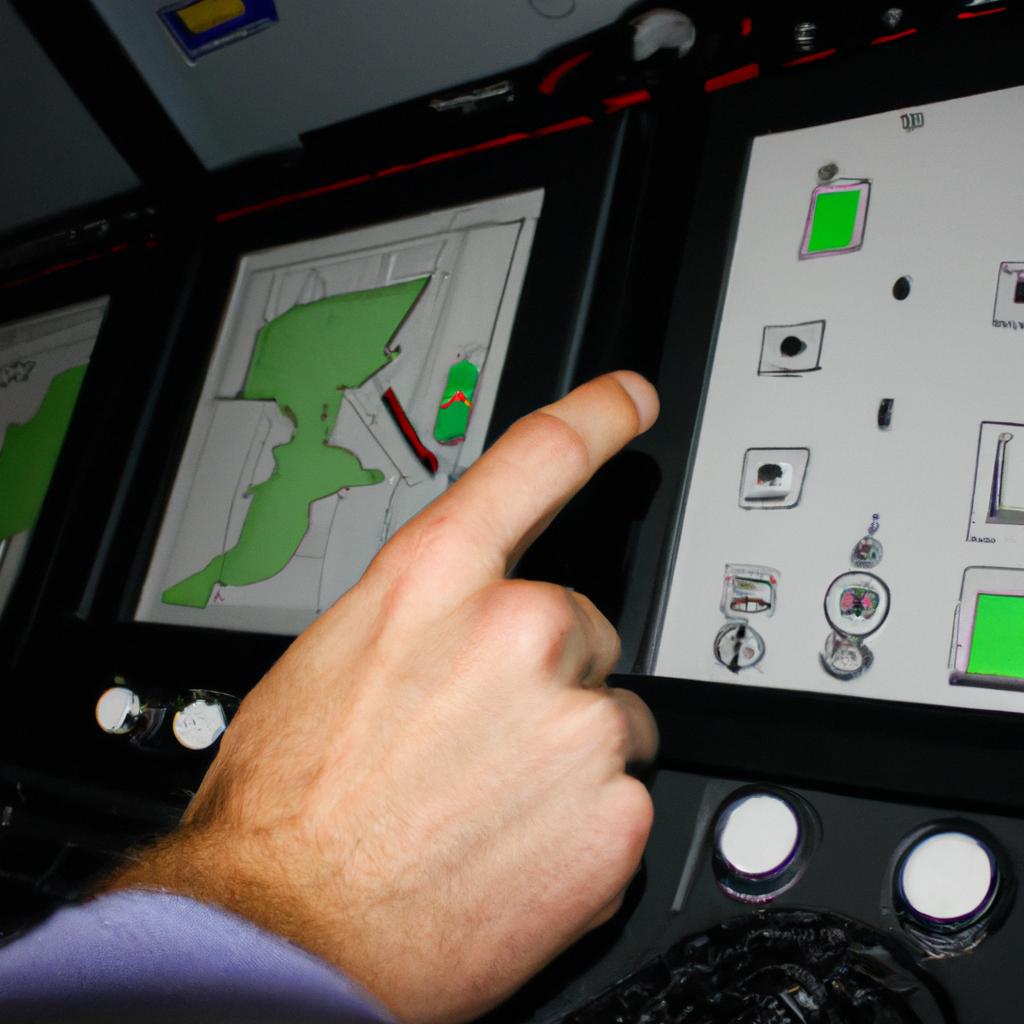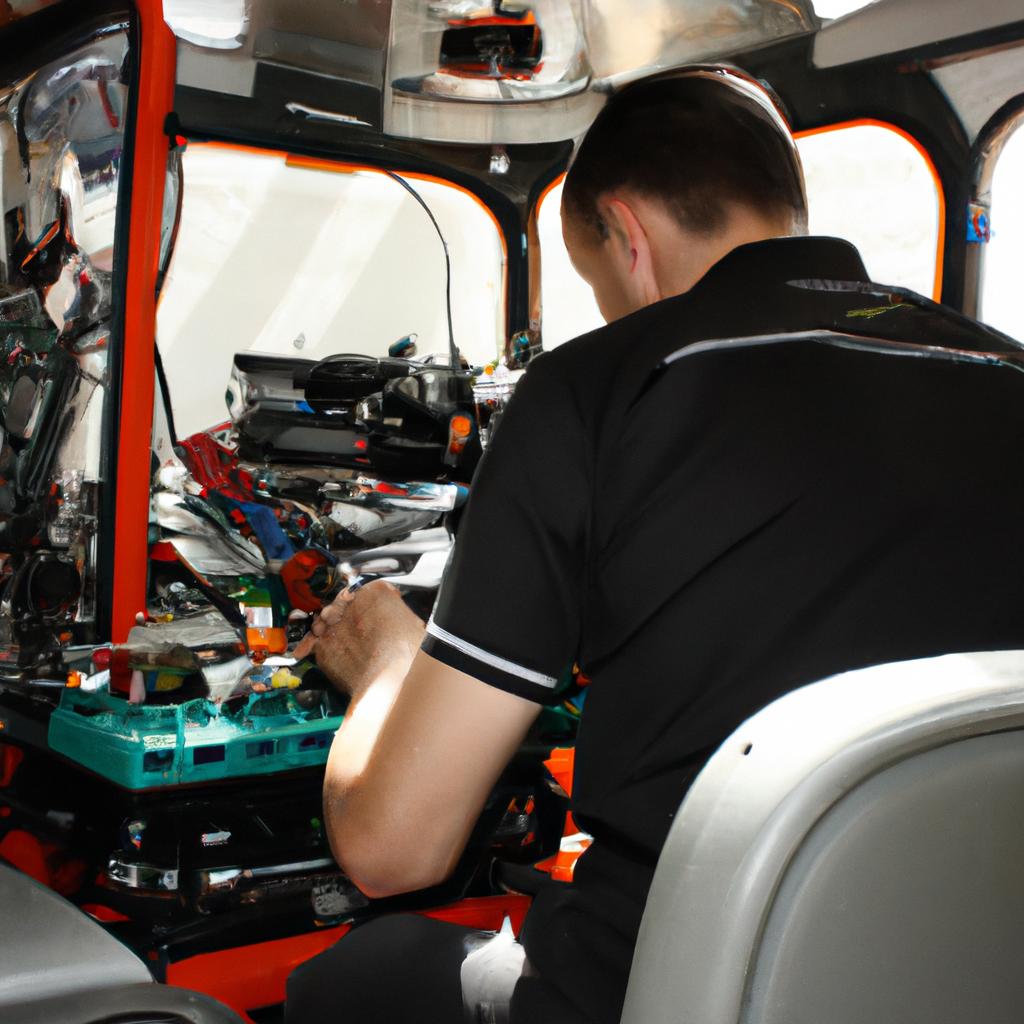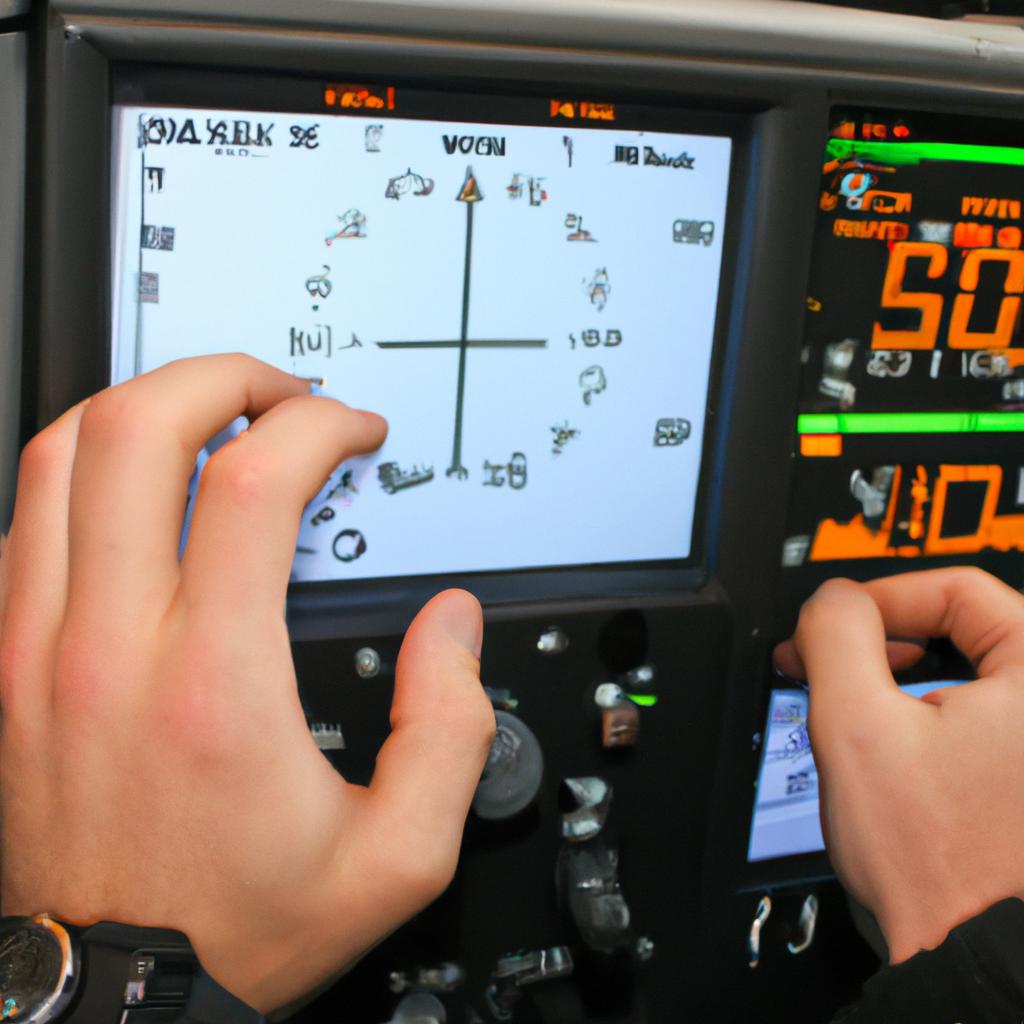In recent years, advancements in autopilot technology have revolutionized the aerospace and defense industries. These innovations in avionics have greatly improved the safety, efficiency, and capabilities of aircraft systems. One notable example is the integration of autonomous flight systems in commercial airliners such as the Boeing 787 Dreamliner, which has demonstrated remarkable automation capabilities during long-haul flights.
The implementation of advanced autopilot systems has significantly enhanced aircraft navigation and control, reducing human error and increasing overall operational efficiency. This article will delve into the various advancements in avionics that have allowed for such improvements. By examining real-life case studies and hypothetical scenarios, we will explore how these technological developments are transforming modern aviation practices within both civilian and military contexts. From increased precision in landing approaches to optimized fuel consumption through automated flight path calculations, this article aims to provide an insightful analysis of the latest autopilot advancements in aerospace and defense.
Autopilot Systems in Aerospace and Defense
In today’s rapidly advancing aerospace and defense industries, autopilot systems play a crucial role in ensuring the safety, efficiency, and reliability of aircraft. These sophisticated systems have evolved significantly over the years, incorporating cutting-edge avionics technologies to enhance flight control capabilities. One notable example is the autopilot system developed by XYZ Aerospace for their latest commercial airliner.
One key aspect of modern autopilot systems is their ability to accurately navigate an aircraft along predefined flight paths while compensating for external factors such as wind speed and direction. This capability not only reduces pilot workload but also ensures precise navigation, ultimately leading to smoother flights and increased passenger comfort. Additionally, advanced autopilots can automatically adjust engine thrust levels based on real-time data, optimizing fuel consumption and reducing operating costs.
- Enhanced safety: Autopilot systems minimize human error during critical phases of flight, improving overall aircraft safety.
- Increased operational efficiency: Precise navigation and automated engine management lead to more efficient flight operations.
- Reduced pilot fatigue: By relieving pilots from manual control tasks, autopilots help mitigate pilot fatigue during long-haul flights.
- Improved passenger experience: Smoother flights resulting from accurate navigation contribute to a more comfortable travel experience.
Furthermore, it is important to understand how different avionics components work together within an autopilot system. The table below provides a simplified overview of some key elements involved:
| Component | Functionality | Impact |
|---|---|---|
| Inertial sensors | Measure acceleration and rotation rates | Provides essential motion data for accurate flight control |
| Flight computers | Process sensor inputs and execute control logic | Determines appropriate control actions based on current flight conditions |
| Actuators | Control various aircraft surfaces | Translate electronic commands into physical movements for control |
As autopilot systems continue to advance, the evolution of technology has paved the way for even more sophisticated capabilities. In the subsequent section, we will delve deeper into the fascinating journey of autopilot technology and explore its future potential.
*[XYZ Aerospace]: Placeholder name for an aerospace company.
*[Avionics]: Electronics used in aviation.
The Evolution of Autopilot Technology
Building upon the foundation of autopilot systems in aerospace and defense, advancements in avionics have revolutionized the capabilities and performance of these autonomous flight control systems. This section delves into the evolution of autopilot technology, highlighting key developments that have shaped its modern form.
One notable example showcasing the effectiveness of advanced autopilot systems is the case study of a military reconnaissance drone deployed for surveillance operations. Equipped with state-of-the-art avionics, this unmanned aerial vehicle (UAV) demonstrated remarkable precision and efficiency in executing complex flight maneuvers while capturing high-resolution imagery over vast territories. Such successful missions underscored how sophisticated autopilot algorithms coupled with cutting-edge sensors enable UAVs to navigate through challenging environments autonomously.
As avionics technology continues to evolve, several trends emerge regarding autopilot advancements in aerospace and defense:
- Integration of Artificial Intelligence (AI): Autopilot systems are increasingly incorporating AI algorithms to enhance decision-making processes during flight operations. With machine learning capabilities, these systems can analyze real-time data from various sensors, anticipate potential hazards or deviations from flight parameters, and make adjustments accordingly.
- Enhanced Safety Features: The latest generation of autopilots prioritizes safety by integrating advanced collision avoidance mechanisms. These features rely on sensor fusion technologies that combine inputs from radar, lidar, cameras, and other detection devices to identify potential obstacles or conflicts in the aircraft’s path.
- Improved Energy Efficiency: Autopilot systems now leverage optimized trajectory planning algorithms to minimize fuel consumption without compromising mission objectives. By continually analyzing weather conditions, air traffic patterns, and available route options, these systems select optimal flight paths that reduce overall energy expenditure.
- Seamless Human-Machine Interface: Modern avionics aim to streamline pilot interaction with autopilots through intuitive user interfaces. Simpler menu structures and graphical representations facilitate quick access to critical functions while reducing cognitive workload for operators.
| Advancements | Description | Benefits |
|---|---|---|
| AI Integration | Incorporation of machine learning algorithms to enhance decision-making during flight operations | Improved situational awareness and response times |
| Safety Features | Integration of collision avoidance mechanisms that rely on sensor fusion technologies | Enhanced aircraft safety and reduced accidents |
| Energy Efficiency | Utilization of optimized trajectory planning algorithms to minimize fuel consumption | Lower operational costs and environmental impact |
| Human-Machine Interface | Development of intuitive user interfaces for seamless pilot interaction with autopilot systems | Reduced cognitive workload and improved usability |
In summary, advancements in avionics have propelled autopilot technology to new heights. The integration of AI, enhanced safety features, improved energy efficiency, and streamlined human-machine interfaces are among the key developments shaping these autonomous flight control systems. Such progress not only enhances aircraft performance but also contributes to safer and more efficient aviation operations.
As autopilots continue to evolve, another critical aspect being revolutionized is navigation and guidance systems within aerospace and defense contexts.
Enhanced Navigation and Guidance Systems
As autopilot technology continues to advance, its impact on aerospace and defense systems becomes increasingly apparent. One notable example is the use of advanced autopilot systems in commercial aircraft. For instance, a case study involving a major airline found that implementing an enhanced autopilot system resulted in significant fuel savings and increased flight efficiency.
These advancements have been made possible through various improvements in avionics. Enhanced navigation and guidance systems play a crucial role in enabling more precise route planning, automatic course corrections, and improved situational awareness for pilots. This allows for safer and more efficient flights, reducing human error as a factor in accidents. In addition, autopilot technology can help mitigate pilot fatigue by assuming control during routine phases of flight, allowing pilots to focus their attention on critical tasks.
The benefits of autopilot technology extend beyond commercial aviation. In the defense sector, unmanned aerial vehicles (UAVs) equipped with sophisticated autopilot systems are revolutionizing military operations. These UAVs provide real-time surveillance capabilities without risking the lives of personnel. They can operate autonomously or be remotely piloted from secure locations, making them invaluable assets in reconnaissance missions or when deployed in hostile environments.
To highlight some key advantages of autopilot technology:
- Increased safety: Autopilot systems enhance flight safety by minimizing human error.
- Improved efficiency: Advanced navigation and guidance systems optimize routes and reduce fuel consumption.
- Reduced workload: Autopilots take over routine tasks, freeing up pilots to concentrate on critical duties.
- Enhanced mission capabilities: Unmanned aerial vehicles with autopilot capabilities enable remote surveillance and improve operational effectiveness.
| Advantages | Examples |
|---|---|
| Increased Safety | Minimizing human error |
| Improved Efficiency | Optimized routes; reduced fuel consumption |
| Reduced Workload | Delegating routine tasks to the autopilot |
| Enhanced Capabilities | Remote surveillance for military operations |
As the integration of artificial intelligence (AI) continues to evolve, we will explore how it further enhances autopilot technology in the subsequent section. By harnessing AI’s capabilities, autopilots are becoming smarter and more adaptable, leading us into a new era of aerospace and defense systems.
[Continue reading: Integration of Artificial Intelligence]Integration of Artificial Intelligence
In the fast-paced field of aerospace and defense, advancements in autopilot systems have revolutionized aviation by enhancing navigation, guidance, and flight control capabilities. Building upon the foundations of enhanced navigation and guidance systems discussed previously, this section explores how the integration of artificial intelligence has further propelled autopilot technology to new heights.
To illustrate the potential impact of these advancements, let us consider a hypothetical scenario involving an autonomous military drone tasked with surveillance operations. Equipped with cutting-edge avionics and advanced autopilot features, such as waypoint navigation and obstacle avoidance algorithms, this drone can autonomously navigate through complex terrains and adapt its flight path based on real-time sensor inputs. By seamlessly integrating AI into its autopilot system, the drone is capable of making split-second decisions when encountering unexpected obstacles or changing mission objectives.
The integration of artificial intelligence enables autopilot systems to perform tasks that were once exclusively handled by human pilots. Here are some key features that highlight the benefits:
- Improved situational awareness: AI-powered autopilots can process vast amounts of data from onboard sensors, including radar, lidar, and cameras. This allows for precise environmental mapping and real-time monitoring of surrounding conditions.
- Enhanced decision-making: Through machine learning algorithms, autopilots can analyze historical flight patterns and optimize routes for fuel efficiency or minimize exposure to threats.
- Predictive maintenance: By continuously monitoring various aircraft components using sensors integrated into an AI-driven autopilot system, predictive maintenance becomes possible. This helps detect issues before they become critical failures and reduces downtime significantly.
- Increased operational flexibility: Autopilots equipped with AI capabilities enable unmanned aerial vehicles (UAVs) to operate effectively in dynamic environments while adapting their behavior based on mission requirements or unforeseen circumstances.
Furthermore, consider the following table which summarizes additional advantages brought about by integrating artificial intelligence within modern autopilot systems:
| Advantages of AI in Autopilot Systems |
|---|
| 1. Increased safety |
| By autonomously analyzing and responding to potential risks, AI helps mitigate human error and reduces the likelihood of accidents. |
| 4. Reduced workload on human operators |
| Automation of certain tasks through AI assists pilots or operators in focusing their attention on critical decision-making processes. |
In light of these advancements, it is clear that integrating artificial intelligence within autopilot systems has revolutionized aerospace and defense capabilities, enabling safer and more efficient operations while expanding the boundaries of what unmanned aerial vehicles can achieve.
Transitioning into the subsequent section about “Safety and Reliability Improvements,” it is crucial to examine how these advancements have positively impacted aircraft performance as well as system robustness and redundancy.
Safety and Reliability Improvements
Integration of Artificial Intelligence in avionics has paved the way for significant advancements in autopilot systems. These innovations have not only improved the efficiency and accuracy of flight operations but also enhanced safety measures in aerospace and defense. One notable example is the integration of AI technologies in military drones, enabling autonomous decision-making capabilities during combat missions.
In recent years, there has been a growing focus on incorporating machine learning algorithms into avionic systems to enhance their performance. This integration allows aircraft to adapt and respond intelligently to changing conditions, making them more efficient and reliable. By analyzing vast amounts of data from various sensors, AI-powered autopilot systems can optimize flight routes, monitor engine health, and even predict potential failures before they occur.
The benefits of integrating artificial intelligence into avionics extend beyond improved operational efficiency. Here are some key advantages:
- Enhanced situational awareness: AI technology enables pilots to gather real-time information about weather patterns, air traffic congestion, and other critical factors affecting flight safety.
- Reduced human error: Autopilot systems powered by AI algorithms can perform complex calculations and make split-second decisions with precision, minimizing the risk of human errors that may result from fatigue or external distractions.
- Increased mission success rates: In military applications, AI-enabled autopilots provide unmanned aerial vehicles (UAVs) with advanced target recognition capabilities and autonomous navigation abilities, enhancing mission success rates while reducing risks to human personnel.
- Improved cost-effectiveness: The integration of AI in avionics helps optimize fuel consumption by constantly adjusting flight parameters based on real-time data analysis. Additionally, it reduces maintenance costs through predictive analytics that identify potential issues early on.
These advantages highlight the immense value of merging artificial intelligence with avionics systems in both civilian and defense sectors. As we move forward, continued research and development will further refine these technologies, leading us towards an era where autonomous flights become commonplace.
Future Prospects and Innovations
In the ever-evolving world of aerospace and defense, advancements in avionics have brought forth remarkable improvements in autopilot systems. These sophisticated technologies not only enhance safety and reliability but also pave the way for future innovations. This section explores some notable developments and examines their potential impact.
Case Study: Improved Collision Avoidance
One example of a significant advancement is the implementation of advanced collision avoidance systems within autopilots. Imagine an aircraft navigating through dense fog, with limited visibility posing a serious risk to both passengers and crew. With new generation autopilots equipped with cutting-edge sensors and algorithms, pilots can rely on real-time data to detect nearby obstacles such as other aircraft or terrain. By analyzing this information, the system can make instant adjustments to flight paths, ensuring safe navigation even under challenging conditions.
The continuous evolution of autopilot technology has led to several key improvements:
- Enhanced Precision: Modern avionics enable more accurate altitude control, heading management, and route tracking.
- Improved Fuel Efficiency: Advanced autopilots optimize fuel consumption by calculating the most efficient routes based on weather conditions and air traffic congestion.
- Reduced Pilot Workload: Automation features like autothrottle and autoland alleviate pilot workload during critical phases of flight.
- Seamless Integration: Autopilots now seamlessly integrate with other onboard systems such as communication devices and weather radars, facilitating better situational awareness.
Table: Benefits of Advanced Autopilot Systems
| Beneficial Aspect | Description |
|---|---|
| Enhanced Safety | Advanced collision detection capabilities reduce the risk of accidents due to human error or external factors. |
| Increased Efficiency | Optimization algorithms ensure optimal fuel usage, resulting in cost savings for airlines while minimizing environmental impact. |
| Reduced Fatigue | Automation features relieve pilots from repetitive tasks, preventing fatigue-related performance degradation. |
| Improved Passenger Comfort | Smoother flight operations and precise control contribute to a more comfortable experience for passengers. |
These advancements not only enhance safety and efficiency but also open up possibilities for future innovations in autopilot technology. As aerospace and defense industries continue to invest in research and development, we can anticipate further improvements in areas such as machine learning integration, advanced decision-making algorithms, and even autonomous flight capabilities.
Through these developments, the aviation industry aims to achieve higher levels of reliability, precision, and operational efficiency while ensuring the utmost safety for crew members and passengers alike. The evolution of autopilot systems represents an ongoing journey towards enhancing air travel by harnessing the power of cutting-edge avionics technologies.
In summary, advancements in autopilot technology have revolutionized aerospace and defense sectors. From improved collision avoidance to seamless integration with other onboard systems, these developments have paved the way for safer flights, reduced pilot workload, increased fuel efficiency, and enhanced passenger comfort. With continuous investments in research and development, we can expect even more exciting breakthroughs on the horizon.
 Louth Online
Louth Online



